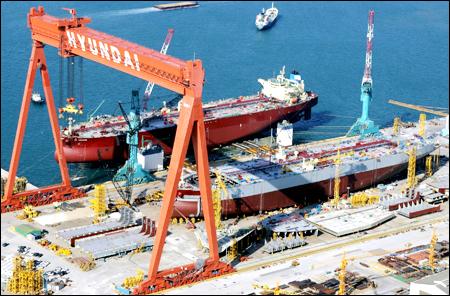World’s Largest Shipbuilder, Hyundai Heavy, to Focus On 3D Printing Ship Parts Via New Innovation Center
 Global trade is the lifeblood of today’s economy. Without it, economies would shrink, jobs would crumble and many of the products we all know and love would not be available to us. By far, the leading enabler of international trade is the cargo shipping industry, which makes up a staggering 90% of all trade commerce. Without the shipping industry, which generates over $500 billion in annual income via freight rates, it is estimated that half of the world would starve.
Global trade is the lifeblood of today’s economy. Without it, economies would shrink, jobs would crumble and many of the products we all know and love would not be available to us. By far, the leading enabler of international trade is the cargo shipping industry, which makes up a staggering 90% of all trade commerce. Without the shipping industry, which generates over $500 billion in annual income via freight rates, it is estimated that half of the world would starve.
Leading the way within the shipping industry is a South Korean company called Hyundai Heavy Industries. With over $50 billion in annual revenue, this 43-year-old company is the largest shipbuilding company on the planet.
Last week, the company made a major announcement in that they are joining the South Korean government’s creative economy initiative by opening an innovation center in Ulsan, the same city that their headquarters are located. The Ulsan Creative Economy Innovation Center will have two different branch locations, one at the University of Ulsan, and the other at the city’s startup assistant center.
“Ulsan is the industrial capital of Korea, where per capita production and incomes are the nation’s highest, specializing in major heavy industries such as shipbuilding, automotive and petrochemicals,” Park Geun-hye, Hyundai Heavy Industries Chairman said during a congratulatory speech. “However, as Korean heavy industries are challenged by nearby countries’ technological advancements, I hope to see the Ulsan Center contribute to giving new life to existing industry by integrating ICT and making it a next-generation growth engine.”
The center will serve multiple purposes. First it will be used to boost the technological capital of Hyundai Heavy. Second it will act as a hub to incubate startups who are involved in 3D printing as well as the automated medical services industries. Hyundai Heavy hopes to boost the industry in general by 3D printing multiple ship components, saving time and money in the process.
The company has also teamed with two other major South Korean shipbuilders, Samsung Heavy Industries, Daewoo Shipbuilding and Marine Engineering. Combined, the three companies will share 2,500 patents with the center’s startups so that they can develop new projects and products which better suit the three patent holders. Ultimately the goal of this initiative will be to bolster the local economy as well as advance the technologies behind the shipping industry.
The three large shipbuilders, along with engineering students at the University of Ulsan and the various startups, will work together on research around new technologies such as 3D printing, aiming to localize the production of 15 major ship parts at the center by year’s end, and as many as 165 different parts by 2018. Hyundai Heavy estimates that such localization of manufacturing could save the Korean shipbuilding industry approximately $1.8 billion annually.
While this isn’t the first time we’ve seen the use of 3D printing within a marine setting (the US Navy has been using 3D printing for some time now), it certainly seems like a move that could drastically increase the importance of the technology on the seas. Let us know your thoughts on this story and how you think 3D printing could eventually change the shipping industry for the better. Discuss in the Hyundai Heavy 3D Printing forum thread on 3DPB.com.
Subscribe to Our Email Newsletter
Stay up-to-date on all the latest news from the 3D printing industry and receive information and offers from third party vendors.
You May Also Like
Precision at the Microscale: UK Researchers Advance Medical Devices with BMF’s 3D Printing Tech
University of Nottingham researchers are using Boston Micro Fabrication‘s (BMF) 3D printing technology to develop medical devices that improve compatibility with human tissue. Funded by a UK grant, this project...
3D Printing Webinar and Event Roundup: April 21, 2024
It’s another busy week of webinars and events, starting with Hannover Messe in Germany and continuing with Metalcasting Congress, Chinaplas, TechBlick’s Innovation Festival, and more. Stratasys continues its advanced training...
3D Printing Webinar and Event Roundup: March 17, 2024
It’s another busy week of webinars and events, including SALMED 2024 and AM Forum in Berlin. Stratasys continues its in-person training and is offering two webinars, ASTM is holding a...
3D Printed Micro Antenna is 15% Smaller and 6X Lighter
Horizon Microtechnologies has achieved success in creating a high-frequency D-Band horn antenna through micro 3D printing. However, this achievement did not rely solely on 3D printing; it involved a combination...






























